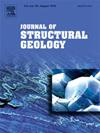Thermo-mechanical intrusion-wall rock interaction and granite emplacement mechanisms of the Peninsula granite at the Sea Point contact, Cape Town, South Africa
IF 2.9
2区 地球科学
Q2 GEOSCIENCES, MULTIDISCIPLINARY
引用次数: 0
Abstract
The Sea Point contact, Cape Town, South Africa exposes the intrusive contact between the ∼540 Ma S-type Peninsula Granite and the ∼560–555 Ma metasedimentary rocks of the Malmesbury Group of the Pan-African Saldania Belt. The western Saldania Belt was subjected to low-grade greenschist facies metamorphism and deformation during the ∼560–540 Ma Saldanian orogeny. The Peninsula Granite intruded as a series of numerous granite sheets which made use of the pre-existing country rock anisotropy in order to propagate. These are the steeply dipping S0 bedding due to folding during the Saldanian orogeny, and a steeply dipping axial planar S2 foliation to the F2 folds developed during the dominant D2 deformation. Magma overpressure relative to tensile stresses in the country rock and regional NE-SW-orientated compressional stresses allowed intrusion of variably crystal-laden magma along the anisotropies. The granitic sheets are commonly concentrated in the hinge zones of F2 folds, where structural traps facilitated magma “trapping.” Filter pressing at the tail of the magma-filled hydrofracture caused closing during magma through-flow resulting in the entrapping of magmatic crystals, most notably K-feldspar megacrysts, in the wall rock as well as xenoliths dislodged during magma infiltration and stoping, and possibly magma flow. Magma stresses have brought about the alignment of K-feldspar megacrysts as well as the long axes of xenoliths parallel to the orientation of granite sheets and wall rock septa in the complex lit-par-lit zone and adjacent to the contact. A degree of assimilation (and possibly partial melting) is evident in the rounded shapes of xenoliths, but, more notably in mixed zones where there are gradational contacts not only between different granite types, reflecting multiple granite pulse intrusion, but also between the granites and wall rock, giving rise to hybrid granites. Xenoliths with remnant S0 and S2 were picked up and rotated during magma flow, with some embedded in the wall rock during filter pressing. The timing of granite intrusion relative to deformation is evident from examining contact-metamorphic cordierite porphyroblasts and their inclusions. The variation of inclusion patterns relative to the external foliation indicate that thermal metamorphism and, by implication, magma intrusion, occurred from early D2- to late-D3 deformation with continued flattening of the schist matrix leading to an enveloping of the porphyroblasts by the S2 foliation. The intrusion thus was accompanied by progressive deformation and tightening of the F2 folding. Some granites, notably the coarse-grained megacrystic granite, crosscut other granite types and intruded late-to post-tectonic. Magma loading led to the development of a shallowly dipping, widely spaced S3 crenulation. Subsequent magma injections led to the development of the Peninsula pluton.

南非开普敦海点接触处半岛花岗岩热-机械侵入-围岩相互作用及花岗岩侵位机制
南非开普敦Sea Point接触暴露了泛非Saldania带Malmesbury群~ 560-555 Ma变质沉积岩与~ 540 Ma s型半岛花岗岩之间的侵入接触。西萨尔达尼亚带在~ 560 ~ 540 Ma的萨尔达尼亚造山运动期间遭受了低品位绿片岩相变质和变形作用。半岛花岗岩作为一系列众多花岗岩片侵入,利用原有的乡村岩石各向异性进行繁殖。这是在萨尔达尼期造山运动时期由于褶皱作用形成的陡倾的S0层理,以及D2期主要变形时期向F2褶皱发育的陡倾轴向平面S2层理。相对于乡村岩石中的拉应力和区域ne - sw向挤压应力的岩浆超压使得含晶岩浆沿各向异性侵入。花岗岩片岩一般集中在F2褶皱的折合带,构造圈闭有利于岩浆的“圈闭”。充填岩浆的水力裂缝尾部的压滤作用导致岩浆穿过过程中的闭合,导致岩浆岩晶体(主要是钾长石巨晶)被包裹在围岩中,以及岩浆渗透和回采过程中被移出的捕虏体,可能还有岩浆流动。岩浆应力导致了钾长石巨晶的排列,以及在复杂的亮-半亮带和接触带附近平行于花岗岩片和围岩隔层方向的包体长轴。在捕虏体的圆形中,明显存在一定程度的同化作用(可能是部分熔融作用),但在混合带中,更明显的是,在混合带中,不仅存在不同花岗岩类型之间的逐级接触,反映了多次花岗岩脉冲侵入,而且存在花岗岩与围岩之间的逐级接触,产生了混合花岗岩。含残余S0和S2的捕虏体在岩浆流动过程中被拾取并旋转,部分捕虏体在压滤过程中嵌入围岩。花岗岩侵入的时间与变形有关,从接触变质堇青石斑岩母岩及其包裹体中可以看出。包裹体模式相对于外部片理的变化表明,热变质作用和岩浆侵入发生在D2- d3变形早期至d3变形晚期,片岩基质持续变平,导致成斑岩被S2片理包裹。因此,这种侵入伴随着F2褶皱的渐进变形和收紧。一些花岗岩,特别是粗粒微晶花岗岩,与其他花岗岩类型交叉侵入,晚至后构造期。岩浆加载导致了浅倾斜、宽间距的S3型砾岩的发育。随后的岩浆注入导致了半岛岩体的发育。
本文章由计算机程序翻译,如有差异,请以英文原文为准。
求助全文
约1分钟内获得全文
求助全文
来源期刊

Journal of Structural Geology
地学-地球科学综合
CiteScore
6.00
自引率
19.40%
发文量
192
审稿时长
15.7 weeks
期刊介绍:
The Journal of Structural Geology publishes process-oriented investigations about structural geology using appropriate combinations of analog and digital field data, seismic reflection data, satellite-derived data, geometric analysis, kinematic analysis, laboratory experiments, computer visualizations, and analogue or numerical modelling on all scales. Contributions are encouraged to draw perspectives from rheology, rock mechanics, geophysics,metamorphism, sedimentology, petroleum geology, economic geology, geodynamics, planetary geology, tectonics and neotectonics to provide a more powerful understanding of deformation processes and systems. Given the visual nature of the discipline, supplementary materials that portray the data and analysis in 3-D or quasi 3-D manners, including the use of videos, and/or graphical abstracts can significantly strengthen the impact of contributions.
 求助内容:
求助内容: 应助结果提醒方式:
应助结果提醒方式:


